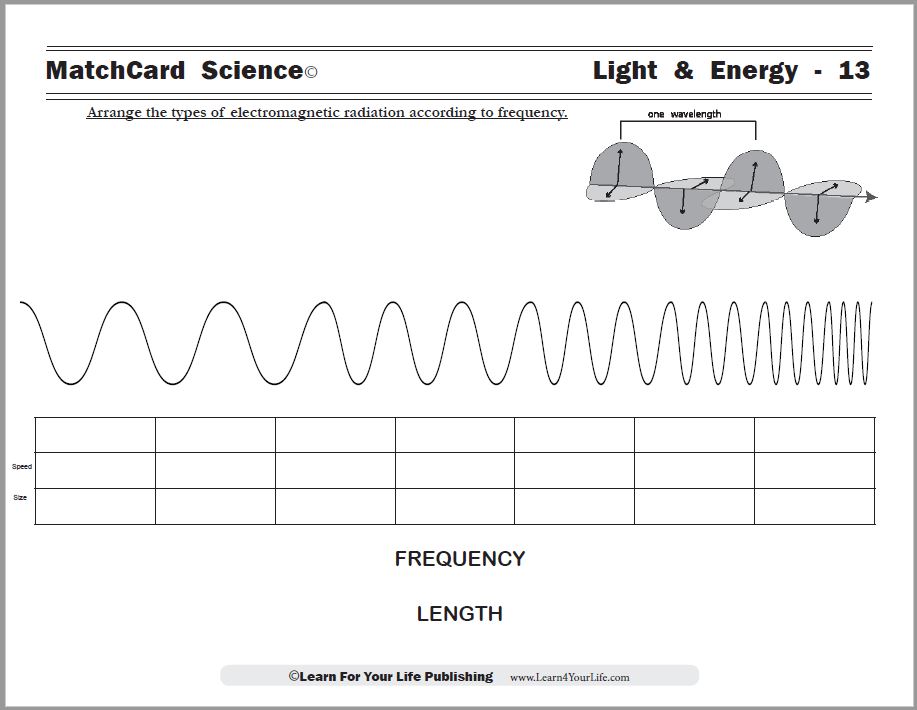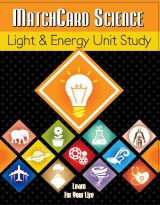Electromagnetic Waves Matchcard
The Electromagnetic Waves MatchCard introduces students to electromagnetic radiation as part of the Light & Energy Unit Study. Activities to compare length of frequency of waves are described.
Free Download Below


Electromagnetic Waves
Objective: Arrange the types of electromagnetic radiation according to frequency.This MatchCard builds on Pitch and Intensity of Sound Waves MatchCard and the Light Spectrum MatchCard for students in 5th through 8th grade.
Download the Electromagnetic MatchCard


This is MatchCard #14 of the Energy Unit Study. Find more information on MatchCard Science below.
What is Electromagnetic Radiation
Electromagnetic radiation is emitted by the sun and stars. It is a form of energy consisting of waves of different sizes and frequencies. Visible light is one form of electromagnetic radiation. Other types also are transmitted to our planet from the sun; but many are filtered out through the atmosphere. Various forms of electromagnetic radiation are used in technology.Types of Electromagnetic Waves
Students will become familiar with the following electromagnetic waves in order of increasing frequency:- Radio waves
- Microwaves
- Infra-red waves
- Light waves
- Ultra-violet waves
- X-rays
- Gamma waves
Electromagnetic Radiation Lesson Plans
Session One
Electromagnetic radiation (EMR for short) is a form of energy released by the sun and stars. One form of EMR you are very familiar with: light!Have you seen pictures of the sun with yellow lines around it showing that light is eminating from the sun? Well, that picture isn’t acturate for a number of reasons.
White Light
As we learned in MatchCard #12, the sun emits light white, not yellow. Of course, a child drawing on white paper needs a yellow crayon and not a white crayon for visibility.The Sun Is 3 Dimensional
Instead of lines coming out of the sun like spokes on a bicycle tire, the EMR radiates out in 3 dimensions, like the glow of a candle in a dark room.The Sun Gives Out All Forms of EMR
Can you guess the other forms of EMR besides visible light? Have you ever heard of X-rays or radio waves? How about microwaves? The sun emits these different types of energy in the form of electromagnetic waves.Wave Frequency
Just as the frequency of the light wave determines color, the frequency of any EMR wave will determine what that wave is. The more frequent the wave, the more powerful it is.MatchCard: Guess the Order by Power of Waves
Show them the student copy of the MatchCard and give them the info pieces with the types of radiation. Let them guess which waves they think are the most powerful (high frequency). Then show the answers.VISIBLE LIGHT
Let’s make this a little easier to learn, so you don’t feel you have to memorize all seven types of waves. You are already familiar with light waves (or visible light.) It goes in the center box. Something to think about: why are light waves also called visible light? Answer: They are the only electromagnetic waves that humans can see.INFRA-RED WAVES
Infra means less than. Since red light is the light with the lowest frequency, the EMR waves that are slower than red light waves are called infra-red light. You can see these waves because they have a lower frequency than the human eye can detect. The sun emits a lot of infra-red radiation, and though you can’t see it, it affects the climate on our planet. Do you know what else besides the sun emits infra-red radiation? You do! Humans and other species give off infra-red waves. That’s what causes a room to get hot when there are lots of people in it. It’s what snakes and other animals detect when they are hunting. Since infra-red is lower than light waves, put it to the left of visible light.ULTRA-VIOLET WAVES
Ultra means more than. Ultra-violet radiation has a greater frequency than light waves. So it goes to the right on the chart on the MatchCard. Have you ever heard of UV radiation? Sunscreen helps to block out the UV radiation from the sun which can disrupt our skin cells and cause skin cancer.Ultra-Violet Sunblock Experiment
Take one sheet of black construction paper and fold into quarters. Lay it outside in the direct sunlight. You might want to put a rock in the very center to prevent the wind from carrying it away. Now you are going to apply sunscreen to different sections of the paper to see how well it blocks UV waves. 1. Leave the first quarter blank. It is the control. 2. Put stripes of sunscreen in the second block. 3. Cover the third and fourth blocks completely with sunscreen, like you would do for your arms. 4. You will reapply the sunscreen only in the fourth block. Reapply it every hour. After three hours, take your paper inside and compare the different blocks.Let's Look at Invisible Ultraviolet Light
Put some tonic water (available at grocery stores) in a clear glass. Leave it in the direct sun for several hours. Close to noon, when the sun is the brightest, put a black cloth or paper behind the glass. Look at the surface of the water at eye level. You should see a faint violet glow.Little More UV Fun
You might like to play around with ultraviolet beads (less than $10 at craft store) or ultraviolet flashlight ($10 in electronics.)Session Two
Review Size and Frequency
We learned in MatchCard 3 that size and frequency of waves are inverse: that is the bigger the wave, the slower it’s frequency. It was also true of the different colors of light waves we explored in MatchCard #12. It’s an important point to keep in mind. Use the arrows on the MatchCard to show that the frequency increases as the size decreases..Four More Types of EMR Waves
As a review, have the students put the light waves, infra-red and ultra-violet in the three middle boxes. Put the other four off the MatchCard. Two of these four waves are slower, larger, and less damaging then light waves. Two types of waves are smaller, faster, and have greater potential to cause damage.The low frequency waves include radio waves and microwaves. X-rays and gamma rays are high frequency waves.
RADIO WAVES
How big is a radio wave? If you look at the chart on the answer key you will see that the waves range from 3 meters to 3 kilometers. Note from the diagram in the upper right hand corner that a single wave is measured from one peak to the next peak. Grab a piece of chalk and draw a single wave (peak to peak with the trough between) on your driveway or sidewalk. Make one bigger than 3 meters.Frequency of Radio Waves
We know that the big waves move slow, right? So how slow are they? On the chart you will see that radio waves are between 10,000 and 10,000,000 hertz. That means at least ten thousand of those waves pass a given point each second. Ten thousand waves per second doesn’t seem too slow, does it? But just look at the other side of the chart, and you’ll find that those little speedy gamma rays get up to 1,000,000,000,000,000,000,000,000 per second.Radio Waves are Not Just For Radios
Can you think of anything besides radios that uses radio waves. Answer: Remote controlled cars and cell phones also use radio waves.Antenna & Tuner
Keep in mind that a radio antenna is bombarded with LOTS of different sizes of radio waves (as well as other EMR waves) every second. But you have a radio tuner that tells your radio WHICH frequency you want. It will only play the sound from a station broadcasting at that frequency. Try turning the tuner on your radio.Build Your Own Radio
There are kits to build your own radio. Check out the kits by Elenco if you are interested. This becomes a life-time hobby for some.Block That Transmission
You learned that aluminum is an electrical conductor in MatchCard #9. Do you think it would be a conductor or an insulator of radio waves? If you have a remote controlled car and remote, wrap the remote in a large sheet of aluminum. Make sure there are no gaps. Now try moving the car. Would you say aluminum is a conductor or insulator of electromagnetic radio waves? Answer: insulatorSession Three
MICROWAVES
Microwaves are faster than radio waves, approximately 100,000,000 to 100,000,000,000 waves per second. Their size ranges from 3 microns to 3 meters.>Time Out for Microns
A micron is the same thing as a micrometer. These numbers below all indicate 1 micron:- 0.000001 meters
- one millionth of a meter
- 10-6
- 1 µ
Uses
You can probably give a quick answer to this question: microwave electromagnetic radiation is used in kitchen microwaves. But it also has other uses in sonar, tele-communications, medicine, and space satellites. The longer, faster waves are more high powered than radio waves so often used for communicating across longer distances.Microwave Fluffy Scrambled Eggs
There are kits to build your own radio. Check out the kits by Elenco if you are interested. This becomes a life-time hobby for some.Session Four
X-RAYS
Have you ever seen an X-Ray of your teeth or bones? X-Rays can be helpful to observe the skeleton. But you may have noticed that you worn a lead apron to protect other parts of your body. That is because too much x-ray radiation can harm your body.The size of the x-ray waves is between .01 nanometers and 10 nanometers. You have to admit that is small. And speedy with a rate of 1,000,000,000,000,000,000 to 100,000,000,000,000,000,000 wave cycles per second.
Nanometers
A nanometer is one billionth of a meter. Remember we can slice a one millimeter thick dime into a thousand microns (at least theoretically.) Then each of those microns can be divided into one thousand nanometers to get one billionth. I like to picture a billion nannies to remember nanometer.Review the Metric System
The cool thing about the metric system is you can use the same prefixes with meters, or liters, or hertz, or bytes, or any other measurement. You should learn the prefixes bolded in the chart below.

Session Five
GAMMA RAYS
Gamma rays are the hot shots of electromagnetic radiation. They are less than 1/100th of nanometer; or 10 picometers or less in size. Their frequency is up to a septillion cycles per second. That’s 1024 hertz. The prefix for septillion is “yotta.” So we can make a tongue twister out of gamma rays:“Ya outta get a lotta yottahertz.”
Well, actually you DON’T want to get a lot of gamma rays because they can be lethal. Sometimes gamma rays are used in medicine to kill cancerous tumors, but they need to be careful that the gamma rays don’t kill other part of the body as well.
Shape of Electro Magnetic Waves
The big diagram on the MatchCard shows a simple picture of waves. Like sound waves, electromagnetic waves have peaks and troughs. But there are actually TWO fields: the electric field and the magnetic field. The small diagram in the upper right hand corner shows that the path of EMR waves is more complicated. The magnetic field has a pathway that is at a 90 degree angle to the electric field.You might like to use strips of fruit roll ups to imitate the peaks and troughs of a wave. Or you can use your fingers to draw the waves in the air. How can you demonstrate the other waves which are perpendicular to them? Just for fun, try to make set of waves with one hand, and the other set with the other hand. Or for an added challenge try one with your hand and one with the opposite foot. Do you think you can make waves with the frequency of one decahertz? Good look trying!
MatchCard Science
How To Use MatchCards

Download the FREE MatchCard Science Instructor's Guide and see how MatchCards can make building their science knowledge base fun.
Light and Energy Unit Study

Download the entire Light and Energy unit study.
12 Science Unit Studies

Chemistry is only one of twelve complete unit studies for kids in 3rd to 8th grade.
Comprehensive objectives, hands-on projects, suggested science fair experiments, and the fun game-like MatchCards keep them interested in learning science. See all twelve MatchCard Science Unit Studies.
About Our Site
Hands-On Learning













